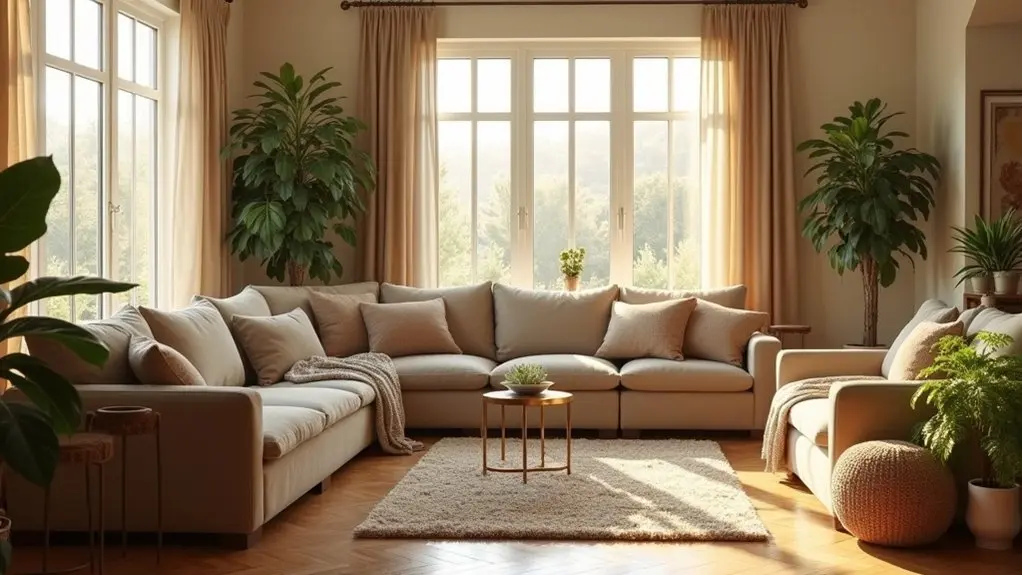
20 Beige Living Room Ideas That Are Warm, Timeless, and Serene
A beige living room achieves warmth and timeless serenity through layered textures—think plush velvets, boucle, or woven rugs—paired with nuanced beige palettes and natural materials like oak or rattan. Accent colors such as black, red, or blue inject modernity, while greenery and varied textiles foster visual interest. Minimalist silhouettes, strategic lighting, and anchor pieces ground the design. Subtle color contrasts and sophisticated furnishings guarantee enduring style, and those seeking expertise will discover inspiring techniques beyond the basics.
Key Takeaways
- Layer various beige tones and textures—like velvet, chenille, and natural wood—for depth, warmth, and timeless appeal.
- Incorporate plush throws, woven rugs, and textured pillows to create a cozy, inviting atmosphere.
- Add accent colors such as red, blue, or black through pillows, art, or furniture for visual interest and sophistication.
- Use greenery and botanical elements to introduce organic texture and enliven beige backdrops.
- Choose minimalist furnishings and maximize natural light to maintain a serene, airy, and modern living room aesthetic.
Add Texture
While beige is often celebrated for its understated elegance, the key to curating a compelling living room lies in the strategic layering of textures.
Designers blend plush fabrics, like velvet or chenille cushions, with smooth wooden surfaces and rugged stone accents, establishing a dynamic interplay that enhances visual interest.
Soft textiles—throws and pillows in nuanced beige hues—introduce subtle depth, while a textured area rug or chunky knit blanket amplifies the cozy atmosphere.
Integrating natural materials such as rattan, oak, or linen not only reinforces warm tones but also connects the space to organic influences, a hallmark of current design trends.
Woven wall hangings or a stone fireplace can soften minimalist lines, fostering an inviting ambiance that’s both timeless and serene.
To create a sophisticated and inviting atmosphere, balance textures like leather and velvet for visual appeal and comfort.
Warm Up a White Room
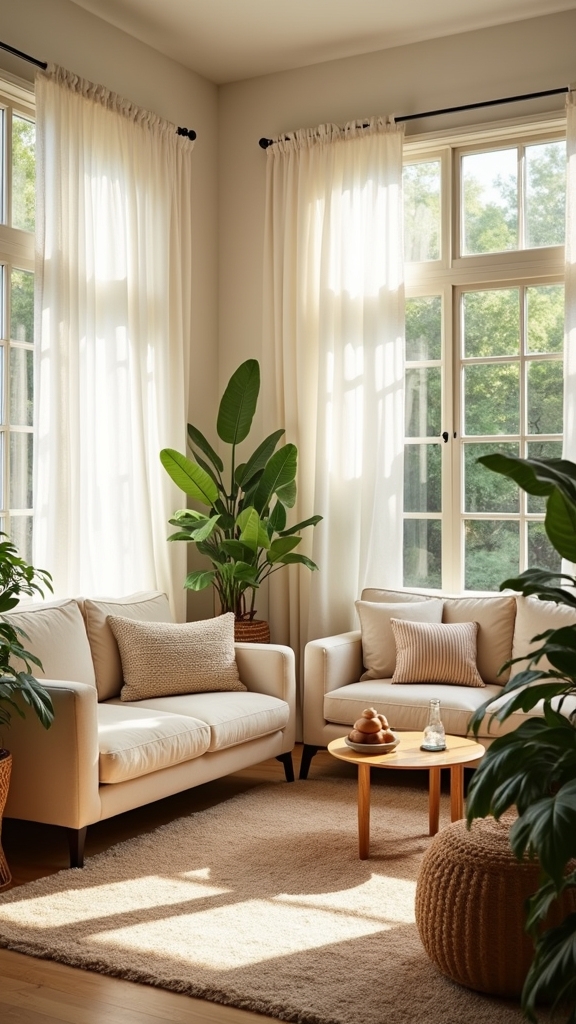
In contemporary interiors, layering pale beige textiles against crisp white walls instantly softens the overall palette, mitigating any sense of sterility.
The addition of natural wood accents introduces organic warmth and visual interest, while still preserving the room’s luminosity.
This harmonious blend of beige, wood, and white embodies a serene, airy aesthetic that is both modern and inviting.
For a truly cozy atmosphere, implement rich tones and layered textiles, which can enhance the inviting feel of the room.
Softening White With Beige
A pristine white room, though celebrated for its crisp modernity, can often feel stark or clinical without thoughtful intervention.
To counterbalance this, design experts recommend integrating beige elements, which naturally soften the visual impact of pure white. The interplay of beige and white cultivates a warm and serene ambiance, steering clear of monotony and harshness.
For a well-balanced aesthetic that aligns with contemporary interior trends, consider the following strategies:
- Layer pale beige textiles—such as throws, cushions, or rugs—to introduce warmth and tactile interest.
- Add subtle beige decor objects, like vases or lamps, to gently diffuse the white palette.
- Incorporate light beige and burnt orange accents to inject depth and visual intrigue.
- Opt for beige upholstered seating to foster softness and a timeless, inviting atmosphere.
Incorporating Natural Wood Accents
Building upon the inviting softness introduced by beige, natural wood accents further enhance a white living room, contributing both visual warmth and architectural interest. Contemporary design increasingly embraces this pairing, where wood’s organic grain and varied undertones prevent the space from feeling clinical. Introducing natural wood beams, streamlined coffee tables, or hardwood flooring seamlessly integrates tactile depth into the neutral palette. Complementing these elements with soft furnishings in pale beige guarantees the atmosphere remains tranquil—never stark. The innate warmth of wood, alongside plush textiles, transforms the room into a cozy living room that feels both timeless and serene. This combination exemplifies today’s trend of blending minimalism with comfort, creating a harmonious retreat.
| Element | Function | Effect on Space |
|---|---|---|
| Wood Beams | Architectural Accent | Adds Depth |
| Coffee Table | Functional Decor | Softens Visuals |
| Flooring | Foundation | Grounds the Palette |
| Soft Furnishings | Comfort Layer | Enhances Coziness |
Achieving Airy Modern Aesthetics
While stark white interiors remain a hallmark of modern design, achieving an airy yet inviting atmosphere relies on strategic use of warm neutrals.
Designers recommend subtly transforming a neutral space by blending beige accents and layering pale hues. This approach tempers the clinical feel of pure white, introducing warmth and depth that align with contemporary style.
The following key strategies guarantee the living area maintains an airy feel without sacrificing comfort or sophistication:
- Integrate pale beige textiles—throws, pillows, and area rugs—to soften hard edges.
- Opt for wood-toned furnishings, enhancing lightness while grounding the space.
- Layer multiple beige shades for visual interest and a cozy, enveloping effect.
- Maximize natural light with large windows to amplify the serenity of beige accents.
Layer Multiple Shades
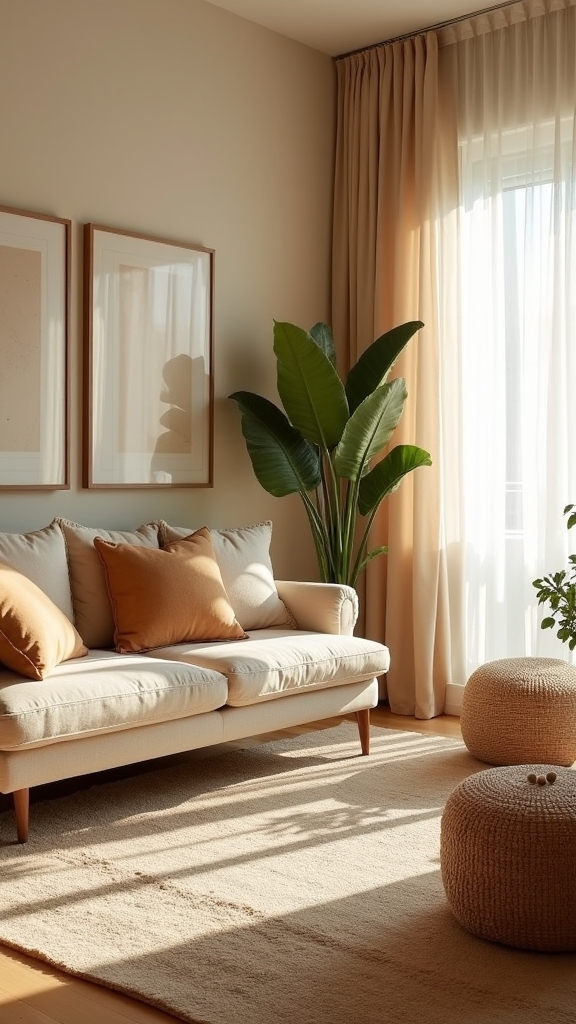
By thoughtfully layering multiple shades of beige—ranging from pale taupe to deep rust—a living room achieves a nuanced depth that enhances both comfort and visual interest. This design approach leverages the subtle contrasts within a harmonious color palette, resulting in a warm beige living room that feels enveloping and cohesive. Layering multiple shades of beige is especially effective in compact spaces, where strategic color variation can create a cozy ambiance without overwhelming the senses. The interplay of tones, inspired by Scandinavian style sensibilities, guarantees a timeless yet contemporary aesthetic. Incorporating tactile materials, such as boucle, natural linen, or textured ceramics, further accentuates the layered effect, providing a multidimensional environment. This method unifies eclectic furnishings, underscoring the room’s serene and inviting character. One can also introduce accent pillows and throws to add subtle color variations and enhance the cozy ambiance of the room.
Go Deep
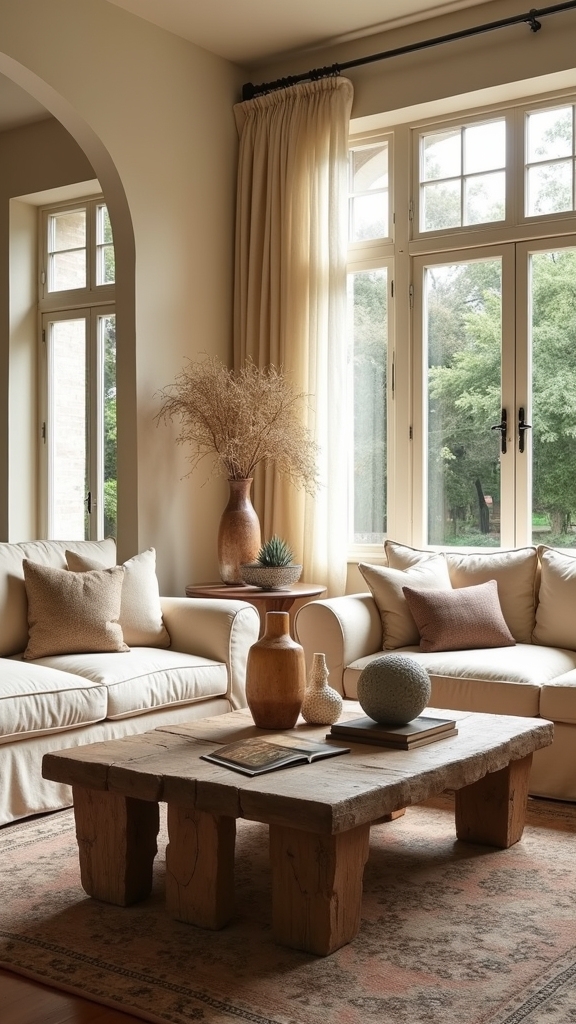
Going deep with beige involves embracing rich honey undertones that infuse the living room with warmth and tranquility.
Layering plush textiles in coordinated beige and brown hues introduces tactile dimension, amplifying comfort and inviting relaxation.
This nuanced palette offers a striking, soft contrast to urban backdrops, aligning with contemporary preferences for sophisticated yet soothing interiors.
Embrace Rich Honey Tones
A rich honey-toned beige transforms a living room with its distinctive warmth and depth, introducing a cozy yet sophisticated foundation for contemporary design.
This color’s golden undertones foster a serene ambiance, imparting a sense of tranquility and inviting relaxation. Honey tones seamlessly bridge classic elegance with modern sensibilities, ensuring a timeless aesthetic that endures beyond fleeting trends.
Designers often recommend embracing these nuanced shades for their ability to enhance spatial perception and soften urban interiors.
To maximize the impact of honey-toned beige, consider these technical strategies:
- Apply honey-toned beige wall paint to heighten warmth and visual depth.
- Contrast with cooler neutrals for layered sophistication.
- Use rich beige to visually expand compact living spaces.
- Integrate honey hues to cultivate a serene, enduring atmosphere.
Layer Plush Furnishings
While neutral palettes often risk appearing flat, strategic layering of plush furnishings in diverse beige tones introduces dimensionality and tactile richness to the living room. Deep honey-hued sofas paired with soft beige armchairs establish an inviting foundation, while textured fabrics such as velvet or boucle contribute nuanced beige textures. These layered textiles, including throws and cushions, enhance comfort and visual interest, encouraging relaxation within a serene ambiance. Warm wood accents—coffee tables, shelving, or trim—complement the plushness, adding organic depth and further amplifying tranquility.
| Beige Element | Impact on Ambiance |
|---|---|
| Plush velvet sofa | Luxurious comfort, warmth |
| Boucle cushions | Tactile intrigue, softness |
| Warm wood accents | Natural grounding, serenity |
This design approach balances sophistication and comfort, making the space a true retreat.
Contrast Urban Softness
Urban sophistication finds balance through the deliberate use of deep beige tones, which temper the stark geometry and industrial finishes characteristic of city interiors.
In urban living rooms, rich honey-toned beige wall paint establishes a warm backdrop, counteracting the coolness of concrete and glass. This nuanced palette is complemented by plush furnishings in varying shades of beige and brown, which enhance the sensory experience and foster a serene retreat.
The interplay of these elements not only softens harsh architectural lines but also invites an enveloping, intimate ambiance.
To achieve this harmonious blend, consider:
- Opt for deep beige wall colors to provide warmth.
- Incorporate layered, soft-textured furnishings.
- Contrast sleek metal or glass with organic beige accents.
- Emphasize cozy lighting for a tranquil atmosphere.
Paint a Beige Border
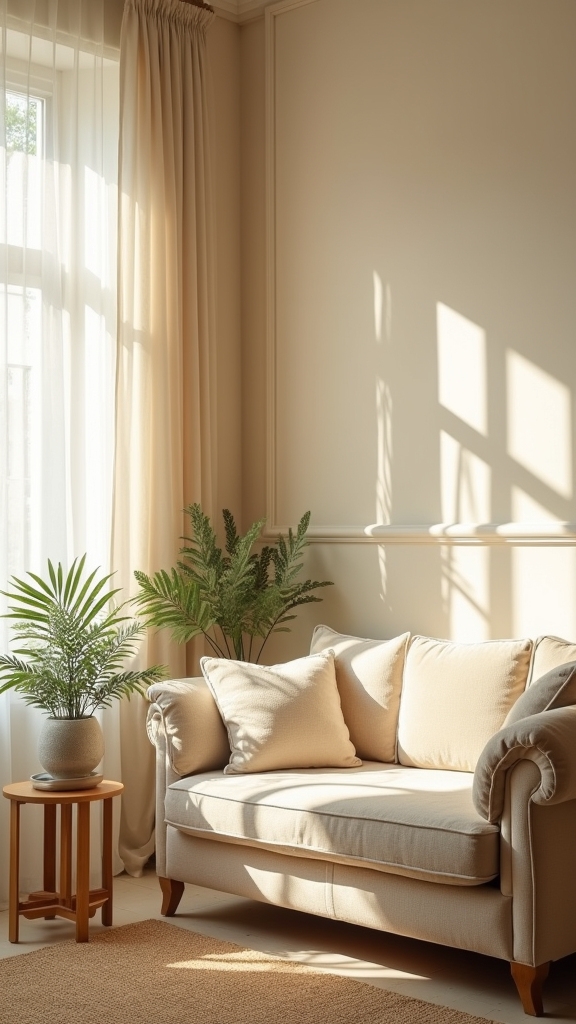
Enhance the architectural appeal of a living room by introducing a taupe beige matte border around the seating area—an approach that visually elongates walls and boosts ceiling height. This design intervention modernizes traditional wall treatments, grounding the furniture arrangement while imparting a cohesive sense of order. The beige border acts as a sophisticated framing device, delineating zones within open-plan spaces and adding visual interest without overwhelming the palette. When paired with lighter wall hues, the boundary line creates a subtle yet striking contrast, accentuating architectural moldings or curated artworks. Particularly suited for expansive or formal living rooms, the beige border method defines social areas, directing the eye and elevating the ambiance. Incorporating natural textures like wooden elements enhances the organic feel of the space, further elevating its warmth and sophistication. This trend-forward technique guarantees the space remains warm, welcoming, and distinctly contemporary.
Use Sepia Tones
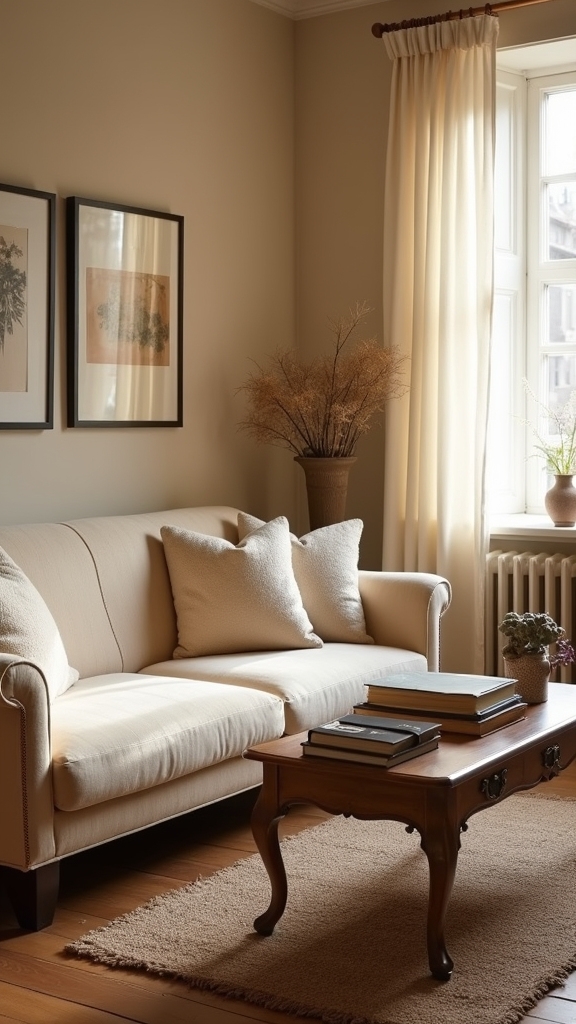
Layering chocolate brown accents amidst sepia-toned walls introduces a sophisticated gradient that underscores warmth and depth in the living room. This approach embraces the current trend for timeless interiors, where plush textures and rich hues promote an atmosphere of enduring comfort. The nuanced interplay of these tones supports a visually cohesive environment, ideal for fostering relaxation and togetherness. Incorporating natural materials and houseplants into the decor not only enhances the aesthetic balance but also adds a touch of vibrancy and life to the space.
Layer Chocolate Brown Accents
Sepia-inspired accents introduce depth and visual intrigue to beige living rooms, utilizing the rich spectrum of chocolate brown tones to achieve a sophisticated yet inviting ambiance.
The strategic layering of chocolate brown accents against a beige backdrop fosters a serene environment, while simultaneously enhancing the space’s timeless look. Design experts recommend blending various sepia tones to create a harmonious and well-balanced aesthetic.
Consider the following techniques:
- Place a chocolate brown velvet sofa as an anchor piece for contrast and comfort.
- Integrate sepia-toned artwork or decorative accessories for visual cohesion.
- Employ textured brown throw pillows and blankets to add warmth and tactile dimension.
- Layer rugs in complementary brown shades to unify and ground the design.
These elements collectively raise the beige living room’s atmosphere.
Embrace Timeless Warmth
Building upon the depth introduced by chocolate brown accents, a beige living room achieves heightened sophistication when sepia tones are thoughtfully incorporated throughout the space.
This nuanced addition to beige living room ideas infuses the interior with a warm palette that feels both nostalgic and inviting. Sepia hues, ranging from soft taupe to deeper rust, envelop smaller spaces in a cozy atmosphere, while seamlessly blending into both traditional and contemporary design schemes.
A chocolate brown velvet sofa, juxtaposed with sepia-toned textiles and wall treatments, anchors the room and raises comfort. The overall effect is undeniably timeless, as sepia’s tranquil undertones foster relaxation and sociability.
This approach guarantees a versatile, enduring aesthetic, making sepia tones indispensable for those seeking a timeless effect in their living environment.
Wash It Out
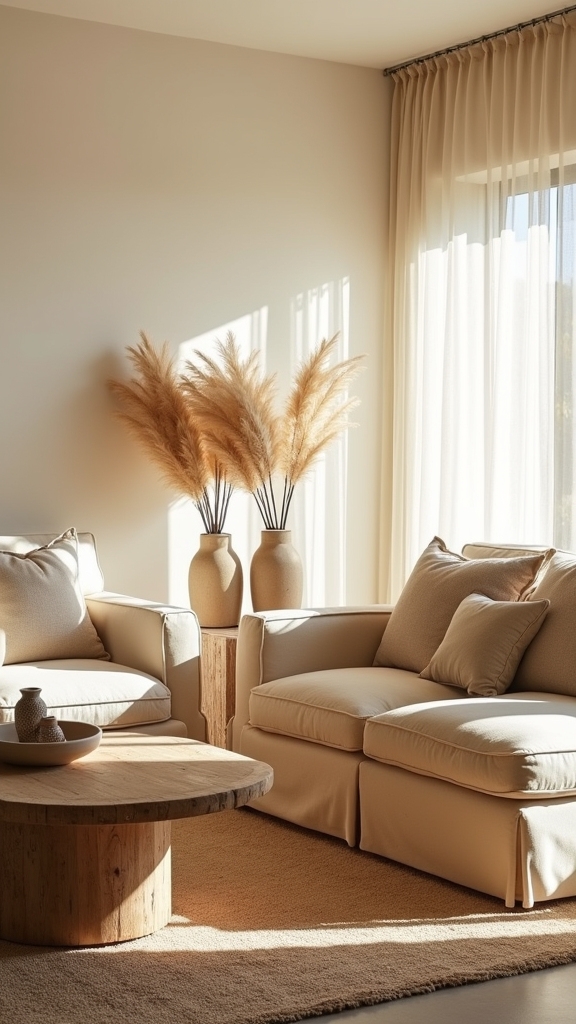
A subtle coffee wash applied to living room walls introduces a nuanced layer of texture and warmth, elevating the classic beige palette with contemporary depth. This washed-out finish, achieved through a delicate layering technique, transforms ordinary surfaces into textured walls that radiate a cozy feel. The approach is particularly effective in cottage-inspired interiors, where rustic elements are accentuated by the interplay of light and softly muted hues. The trend aligns with current preferences for tactile surfaces and atmospheric color stories. Key advantages include: Enhances the beige palette with added dimension and visual interest. Creates textured walls that offer a warm, lived-in aesthetic. Promotes a cozy feel, ideal for inviting and serene living spaces. Brightens darker rooms, subtly reflecting light to transform ambiance. By integrating natural woven-shade lamps, the ambiance is further enhanced with a warm glow and added texture.
Warm Up a Formal Space
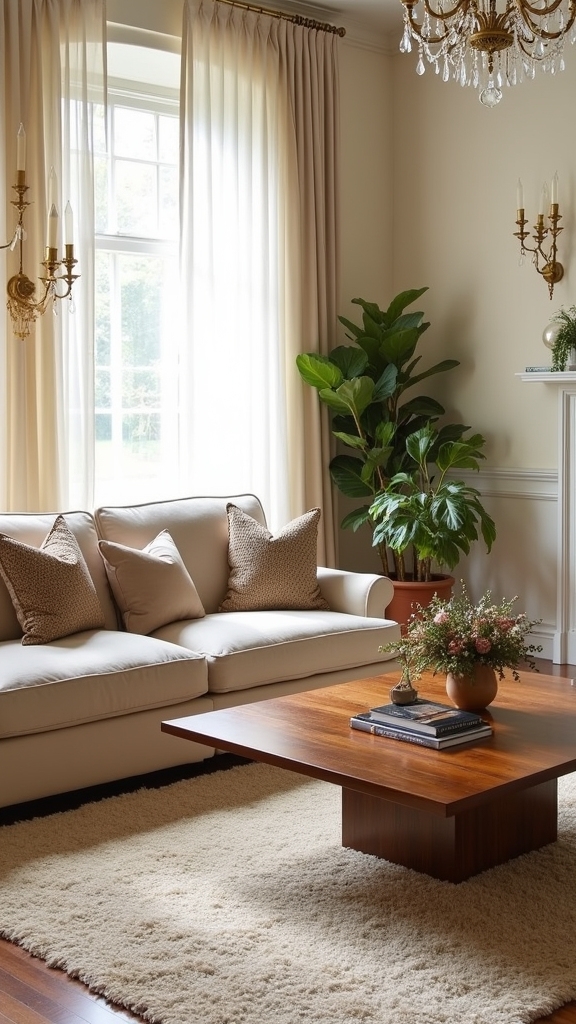
Beige paint introduces a refined warmth to formal living rooms, seamlessly blending sophistication with a sense of comfort.
This versatile hue acts as a neutral canvas, accentuating artwork and designer furnishings while maintaining an open, inviting ambiance.
Enhancing Sophistication With Beige
When seeking to enhance the sophistication of a formal living room, nuanced beige paint offers a refined foundation that accentuates the architectural details and curated furnishings typical of high-end interiors.
Employing beige tones not only raises the visual interest but also preserves a serene environment, making the space both distinguished and welcoming.
The interplay of color, form, and texture creates a harmonious canvas for elegant furnishings and artful accents.
Consider these four strategies to cultivate an atmosphere of raised sophistication:
- Layer various beige tones for depth and visual dimension.
- Integrate plush textiles like velvet or cashmere to soften formality.
- Highlight architectural features with subtle tonal contrasts.
- Curate statement artwork that stands out against a warm, neutral backdrop.
Balancing Warmth and Elegance
While many formal living rooms risk appearing austere, the strategic use of warm beige tones introduces a subtle equilibrium between comfort and sophistication.
Beige walls act as a neutral backdrop, enhancing the refined lines of a sophisticated living room while infusing the space with a gentle warmth. This balance is further achieved through the integration of sumptuous textiles—think plush area rugs, velvet cushions, or linen drapes—layered in tonal variations of beige.
Designer furnishings are accentuated without visual competition, as the understated palette allows for curated artwork and statement pieces to command attention.
Current design trends emphasize this union of warmth and elegance, where beige paint softens formality, inviting relaxation without compromising poise.
The result is a welcoming yet elegant environment that feels both timeless and serene.
Use Desert-Inspired Hues
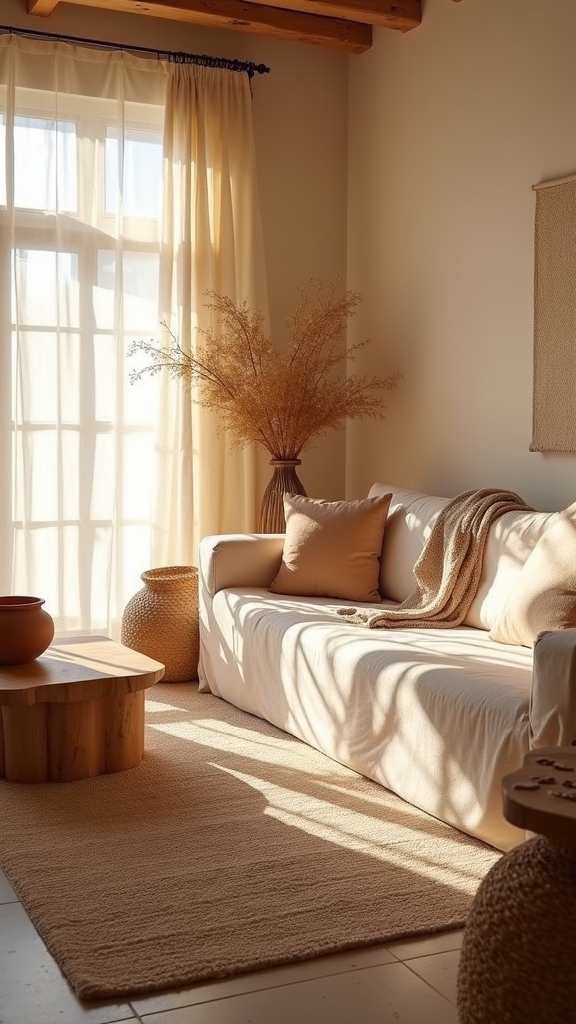
Drawing inspiration from the sunbaked scenery of Southern California, desert-inspired hues infuse living rooms with a tranquil and sophisticated ambiance.
Beige living rooms that utilize these warm tones evoke a serene environment, reminiscent of natural desert vistas. The interplay of sandy neutrals and soft off-whites maximizes natural light, contributing to an expansive, airy effect. Textural elements further reinforce this calming palette.
Consider these technical strategies:
- Incorporate sandy beige and off-white paints to establish a luminous foundation.
- Introduce butterscotch leather sofas for tactile richness and visual warmth.
- Install a beige stone fireplace wall as an architectural focal point, grounding the room’s design.
- Layer natural fibers and subtle desert-inspired textures for depth and authenticity.
Incorporating indoor plants not only enhances visual appeal but also promotes relaxation and improves air quality within the living space.
These elements combine to create a cohesive, inviting retreat.
Accent With Reds and Blues
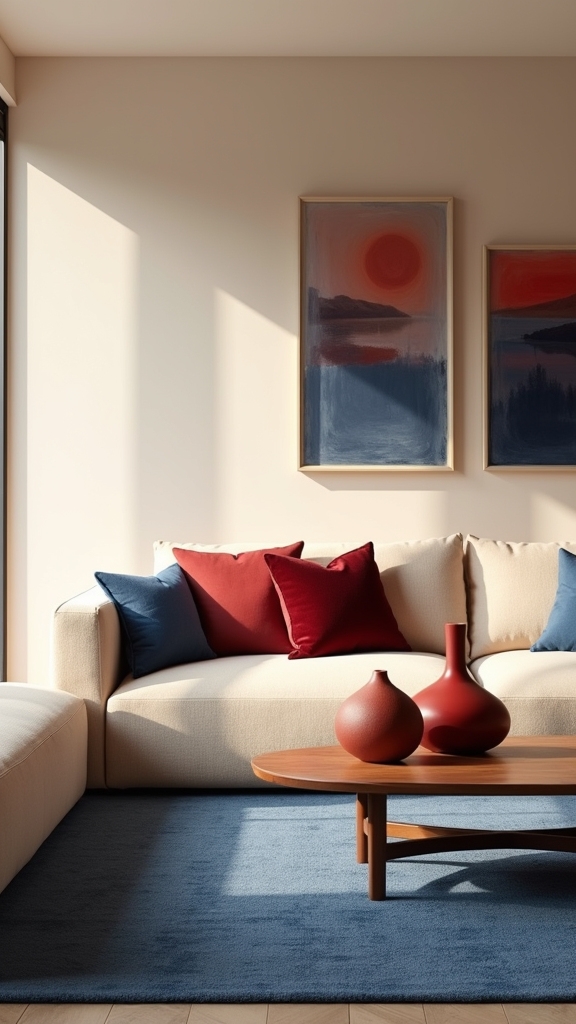
A well-curated selection of red and blue accents introduces a striking layer of visual interest to beige living rooms, transforming pale neutral walls into a dynamic backdrop. By integrating red and blue through throw pillows, artwork, or statement furniture, designers achieve a harmonious balance that enlivens the living space while complementing warm tones inherent in beige accents. The interplay of vibrant reds and cool blues injects energy, fostering a playful yet refined ambiance. Employing an array of textures and patterns in these accent colors further enhances depth and tactile appeal, underscoring current trends favoring layered, sophisticated interiors. Incorporating oversized art transforms the space, adding bold flair and showcasing unique style, which elevates the luxury feel of the living space. This approach positions the living room as both a serene retreat and a hub for social gatherings, where warmth and contemporary elegance seamlessly coexist.
Accent With Black

Beyond the vibrancy of red and blue, black accents redefine the beige living room by introducing bold contrast and visual clarity.
The interplay of beige tones with black accents creates a sophisticated backdrop, enhancing both the warmth and the minimalist aesthetic of the space. Designers increasingly turn to this palette for its enduring, timeless appeal and its ability to suit various interior styles.
Consider these effective strategies:
- Integrate black metal frames on coffee tables or shelving to ground beige furnishings.
- Use black-accented lighting fixtures to punctuate the room and highlight architectural features.
- Incorporate black-framed artwork or mirrors to draw attention to unique wall textures.
- Pair black accessories with warm metallic finishes—like brass or gold—for layered visual interest.
Incorporating metallic accents like gold or bronze alongside black elements adds glamour and sophistication, creating a dynamic interplay in the design. This curated contrast enhances beige living rooms with modern elegance.
Use Warm Stone Finishes
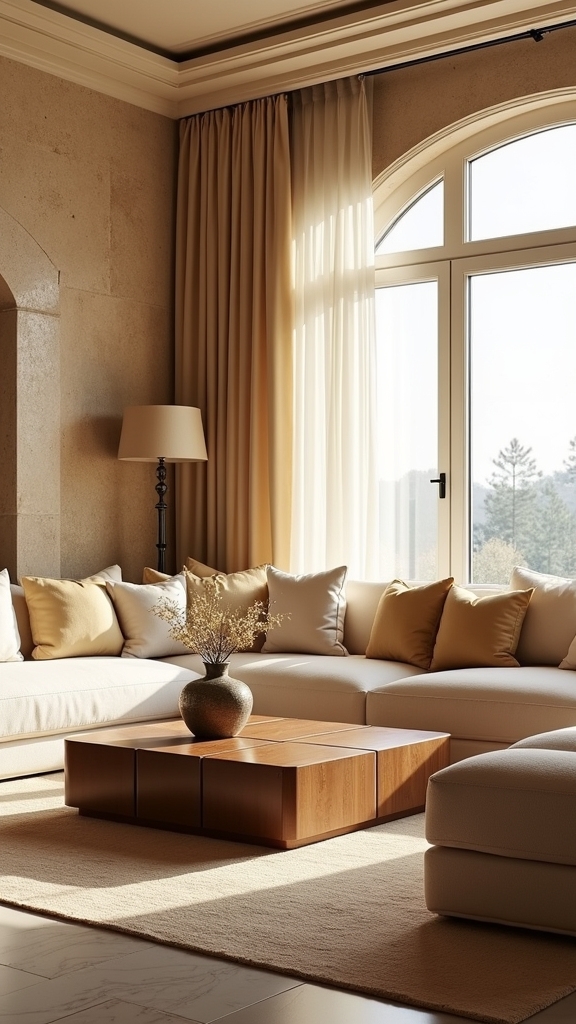
Warm stone finishes introduce an organic sophistication to beige living rooms, seamlessly blending natural textures with contemporary design sensibilities. The integration of beige stone fireplace walls infuses the space with a golden warmth, elevating the cozy ambiance while reinforcing a timeless aesthetic.
Pale beige tile floors, when paired with these stone elements, amplify luminosity, fostering a light and airy atmosphere. Subtle blue accents offer a harmonious counterpoint, balancing the warm tones and providing a nuanced color scheme that feels both fresh and classic.
Warm stone finishes are celebrated for their tactile appeal—their natural textures create visual depth and serene tranquility, promoting relaxation. This versatile design approach resonates across modern and traditional interiors, consistently delivering elegant, enduring style within the beige living room context.
Mix Tones and Textiles
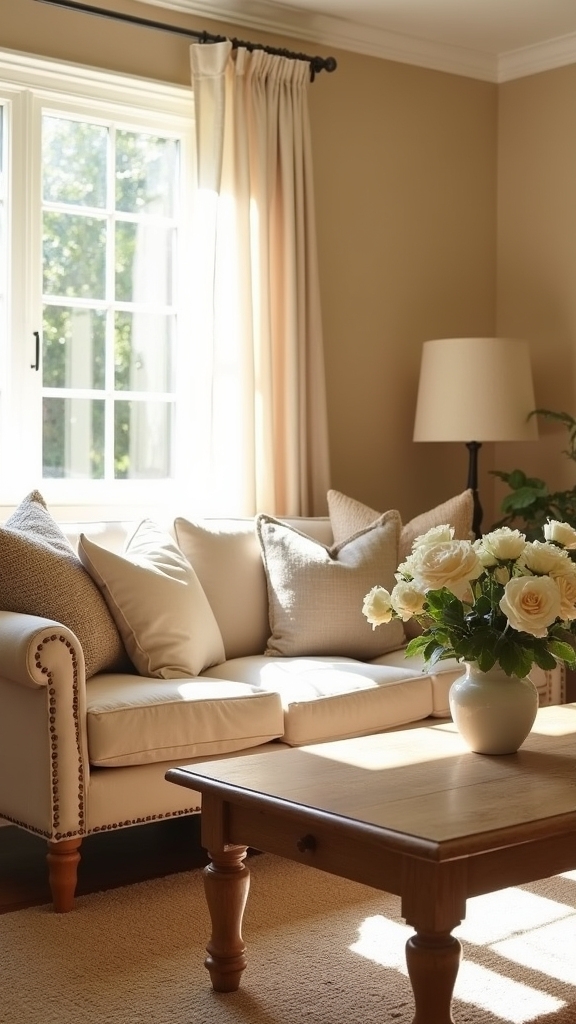
Layering a spectrum of beige tones—from pale taupe to rich rust—infuses the living room with nuanced dimension and visual warmth. Strategic interplay between smooth upholstery, woven throws, and tactile rugs introduces a sophisticated textural contrast, enhancing both comfort and interest. This approach reflects current design trends that favor subtle tonal variation and material diversity for a refined, inviting atmosphere. Incorporating wooden furniture like farmhouse tables can add warmth and charm to the space, further enhancing the rustic appeal.
Layering Varied Beige Hues
When diverse beige tones—from soft taupe to deep rust—are thoughtfully combined, a living room gains both depth and cohesion, reflecting contemporary trends in tonal layering.
Layering varied beige hues is key to crafting a cozy and inviting atmosphere, especially in compact spaces where warmth and intimacy are desired. By integrating multiple shades of beige, designers avoid monotony and infuse the room with subtle visual interest while maintaining a serene environment.
This approach guarantees that the overall palette feels intentional and timeless.
- Select a foundational beige, then vary with accents in lighter and darker hues.
- Layer upholstery, curtains, and rugs in distinct yet harmonious beige tones.
- Incorporate natural wood or stone for added dimension within the palette.
- Use accessories to bridge gaps between multiple shades of beige, enhancing cohesion.
Textural Contrast for Warmth
Building upon the nuanced palette established by varied beige hues, textural contrast emerges as a defining strategy in contemporary living room design.
Designers expertly layer beige tones—from creamy off-whites to earthy rusts—creating visual depth and dimension. The juxtaposition of textiles such as plush velvet, tactile woven fabrics, and supple leathers amplifies both warmth and sensory interest.
Pairing smooth, sleek surfaces with rougher, organic textures—like a minimalist beige sofa adorned with a chunky knit throw—infuses the space with a cozy ambiance while preventing monotony.
This interplay of materials and tones not only enhances the aesthetic but also responds to current trends favoring comfort-driven sophistication.
Ultimately, using textural contrast with a diverse palette of beige tones unifies the room, fostering inviting warmth and timeless appeal.
Keep It Minimalist
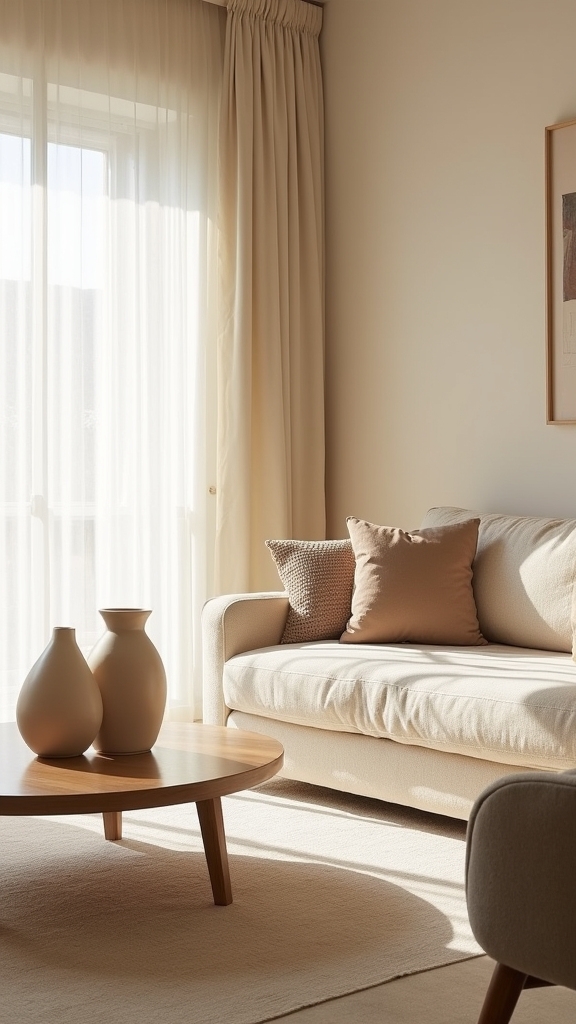
A minimalist approach to beige living room design leverages a restrained palette of pale tones to cultivate an atmosphere of serenity and refined simplicity.
This design ethos focuses on clarity and order, utilizing beige tones to evoke a serene atmosphere while embracing contemporary design principles. The result is a space that feels both tranquil and sophisticated, ideal for modern living.
Key elements in achieving this minimalist aesthetic include:
- Streamlined Furniture: Opt for furnishings with smooth textures and gentle, organic shapes to enhance visual harmony.
- Maximized Natural Light: Incorporate large windows to infuse the room with daylight, heightening its airy, spacious quality.
- Purposeful Decor: Select functional, visually pleasing decor items that serve a dual purpose.
- Clutter-Free Layout: Prioritize open floor plans and minimal ornamentation to uphold a sense of calm.
Accent With Beige
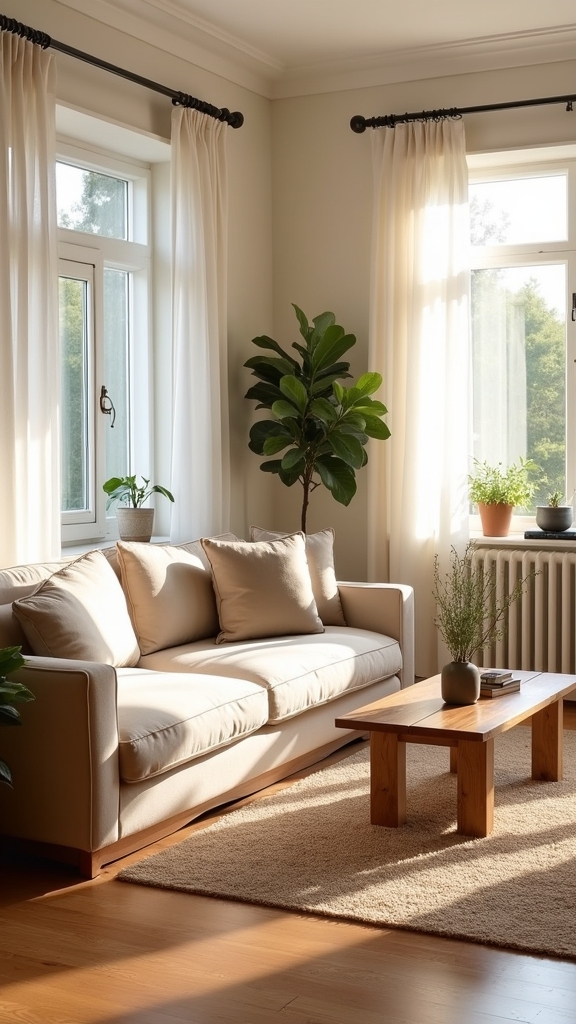
Color theory underscores beige’s versatility as an accent hue, offering a subtle yet impactful means to enhance living room interiors.
In a neutral living room, introducing beige accents—such as a medium-toned beige accent wall—infuses warmth and creates visual harmony, especially when paired with white walls, pale blue textiles, and greige furnishings.
These beige accents cultivate a cohesive color palette that exudes tranquility and comfort, fostering a serene atmosphere without overwhelming the space.
Designers often utilize beige to highlight architectural features or statement furnishings, adding depth and sophistication.
The integration of beige accents also contributes to a timeless aesthetic, making the design both enduring and adaptable across modern and traditional styles.
This approach amplifies spaciousness and guarantees the living room remains effortlessly chic and inviting.
Add Greenery
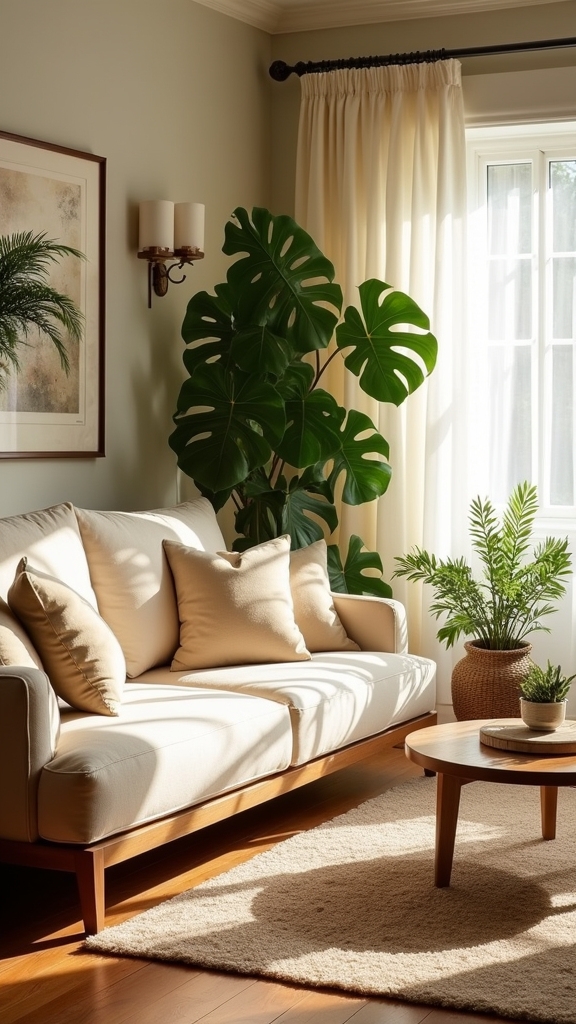
Botanical elements enhance beige living rooms by infusing natural vibrancy and organic texture into the neutral palette. The integration of greenery boosts both the inviting atmosphere and the visual appeal, lending a sense of warmth and dynamic movement.
Deep toffee-toned walls provide a sophisticated backdrop, allowing vibrant green foliage to stand out with striking contrast. To maximize the aesthetic and functional benefits, consider the following:
Deep toffee walls create a refined stage, making lush green plants pop and bringing dynamic contrast to a beige living room.
- Select plants of varying textures and heights to introduce depth and dimension.
- Opt for casual arrangements to soften minimalist design and encourage a tranquil setting.
- Incorporate potted plants and fresh florals for continuous bursts of color and freshness.
- Utilize greenery to subtly improve indoor air quality, reinforcing the rejuvenating ambiance.
Greenery remains a trend-forward strategy for timeless, serene beige living room design.
Add a Beige Anchor Piece
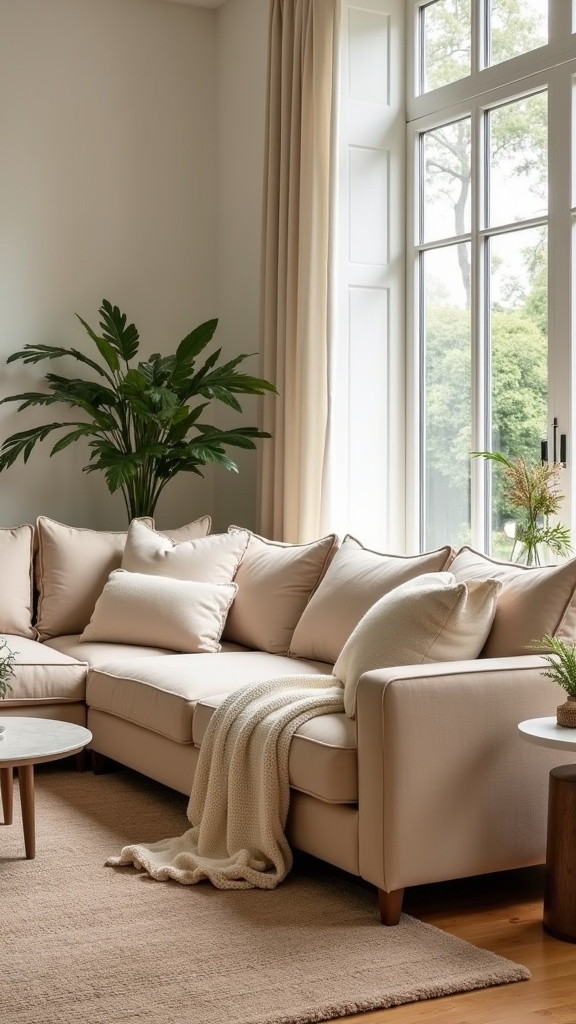
Centrality defines the impact of a beige anchor piece within a living room’s design scheme, establishing a visual nucleus that harmonizes disparate elements. A sandy beige sectional or statement armchair instantly becomes a focal point, its understated tone warming up stark black-and-white spaces and fostering a warm and inviting atmosphere.
The strategic placement of beige furniture contributes to a unified color palette, enhancing design cohesiveness and promoting a tranquil environment. When paired with pale walnut flooring, a beige anchor piece further enhances the room’s aesthetic, underscoring a sophisticated yet approachable ambiance.
This trend-forward approach offers versatility, allowing seamless integration with various accent hues and decor styles. Ultimately, a beige anchor piece serves as both a foundation and a statement within serene living spaces.
Use Varying Textures
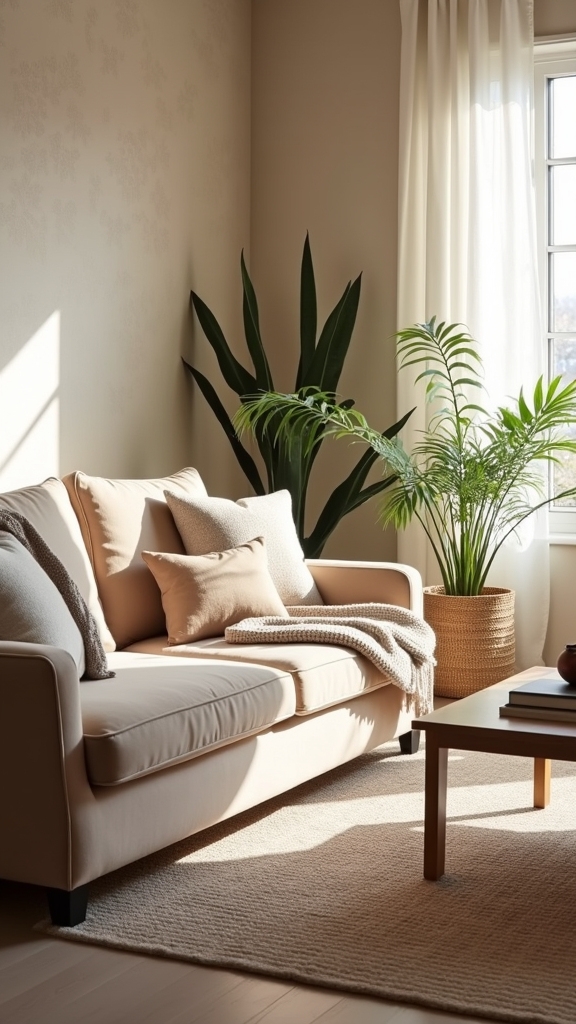
Texture emerges as an essential design element in beige living rooms, elevating neutral palettes through deliberate layering and material interplay.
Varying textures prevent beige spaces from feeling flat, instead infusing them with cozy warmth and visual depth. Contemporary interiors leverage tactile contrasts to invigorate serene environments.
A well-balanced beige living room thoughtfully combines materials and finishes for a multidimensional effect, as illustrated by the following strategies:
- Pair plush upholstery—such as velvet or bouclé—with woven rugs to cultivate inviting comfort.
- Introduce smooth wood surfaces alongside rough stone accents to enhance tactile complexity.
- Layer throw pillows and blankets in different weaves and textiles, adding both comfort and dimension.
- Feature textured wall treatments or art installations to anchor the design and reinforce an engaging, cozy atmosphere.
Mix Warm and Cool Tones

While beige is often associated with warmth, integrating both warm and cool tones within a living room enhances the interior’s visual complexity and contemporary appeal.
A balanced neutral palette—anchored by beige—can be uplifted by infusing cool hues such as pale blue furnishings, which introduce a revitalizing contrast to the space’s inherent warmth.
Strategically placed beige and white patterned area rugs ground the space, their subtle textural interplay harmonizing with both warm and cool elements.
Gauzy drapes in light, neutral shades amplify the airy ambiance, allowing natural light to accentuate the tonal juxtaposition.
This interplay fosters a tranquil yet convivial environment, appealing to modern sensibilities and diverse décor preferences.
The result is a beige living room that feels both inviting and sophisticated, bridging warmth and serenity with measured contrast.
Layer Beige and Brown Tones
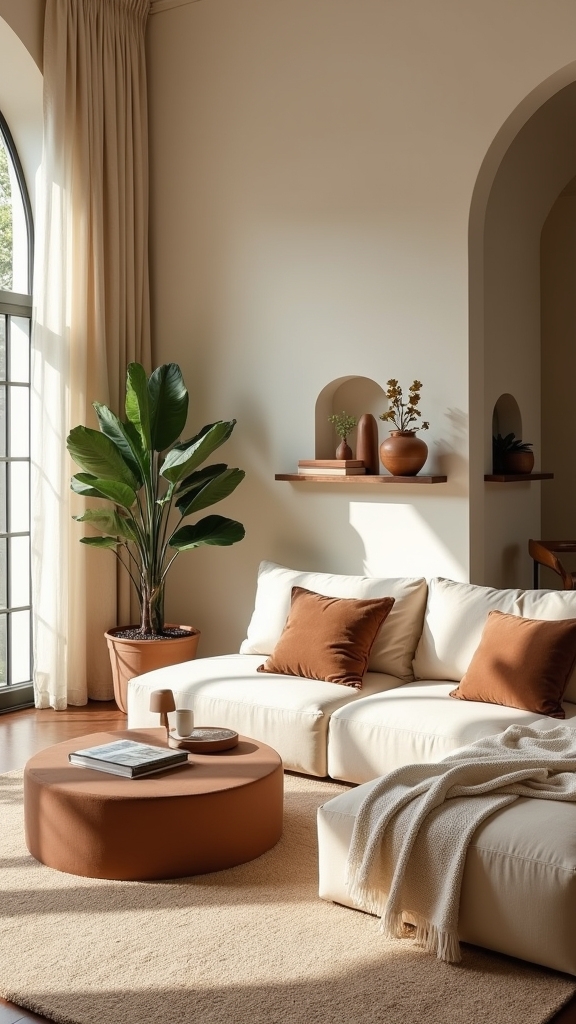
Embracing a sophisticated gradient of beige and brown tones introduces layered depth and a comforting, enveloping ambiance to contemporary living rooms.
This tonal approach enhances spatial perception and cultivates a cozy and inviting atmosphere, making it a sought-after trend in interior design.
The interplay of soft beige wall paint and rich cocoa furnishings provides both warmth and visual interest, while golden accents and antique dark wood elements enhance elegance and cohesion.
- Apply soft beige wall paint for a luminous, tranquil base that visually expands the room.
- Anchor with cocoa-hued furniture to establish depth and contrast within the beige and brown tones.
- Integrate dark wood antique side tables for a touch of classic sophistication.
- Unify with golden accents to achieve a harmonious look and underscore a serene, timeless palette.
Frequently Asked Questions
What Colours Go With Beige in a Living Room?
When selecting complementary hues for a living room, beige color psychology favors tranquility. Soft blues, earthy greens, and chocolate tones integrate seamlessly with beige accent furniture, wall art, and textile patterns, creating an on-trend, harmonious, and visually sophisticated environment.
How to Make a Beige Living Room Pop?
To make a beige living room pop, one should employ accent furniture in bold hues, experiment with texture layering through textiles, prioritize statement artwork selection, and utilize innovative lighting options, aligning with contemporary interior design trends for dynamic visual impact.
How to Make a Beige Room More Interesting?
To enhance visual intrigue in a beige room, designers recommend incorporating beige accent walls, textured fabrics for tactile contrast, layered lighting for depth, and statement artwork as focal points, aligning with contemporary trends in sophisticated, multi-dimensional interior design.
What Color Best Compliments Beige?
When exploring neutral color pairings, soft blues and greens emerge as ideal companions for beige, while warm accent colors like terracotta enhance depth. Contrasting shades, such as navy or charcoal, and texture variations further raise contemporary interior design schemes.
Conclusion
Beige living rooms endure as a trend-forward choice, harmonizing timeless elegance with contemporary sensibilities. Through nuanced layering of textures, strategic use of undertones, and thoughtful juxtaposition of warm and cool hues, these spaces achieve both serenity and visual interest. Whether integrating tonal depth with brown accents or defining borders through paint, beige acts as a versatile foundation. Designers continually revisit this palette, recognizing its adaptability and ability to foster inviting, restorative environments for modern living.
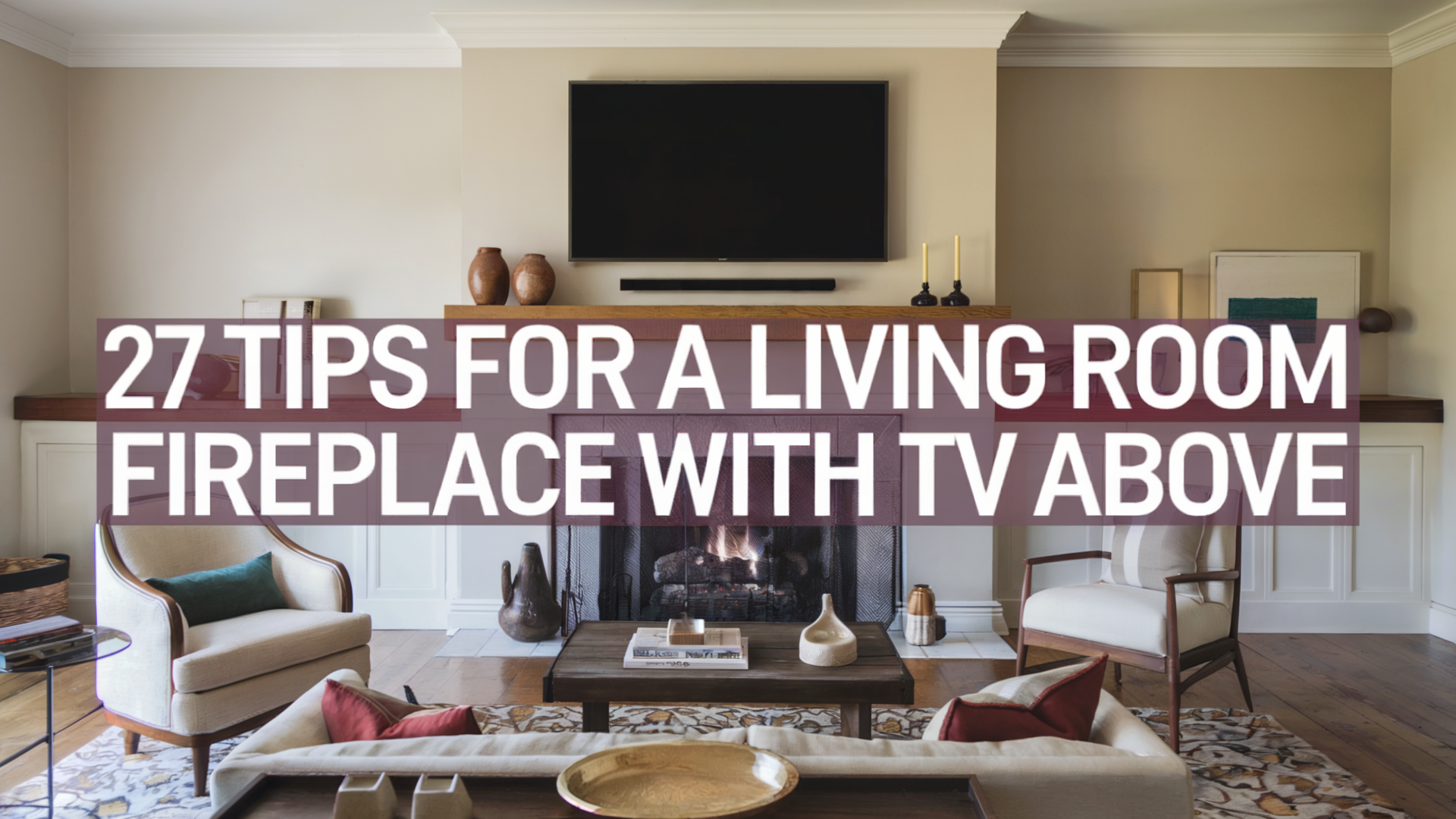
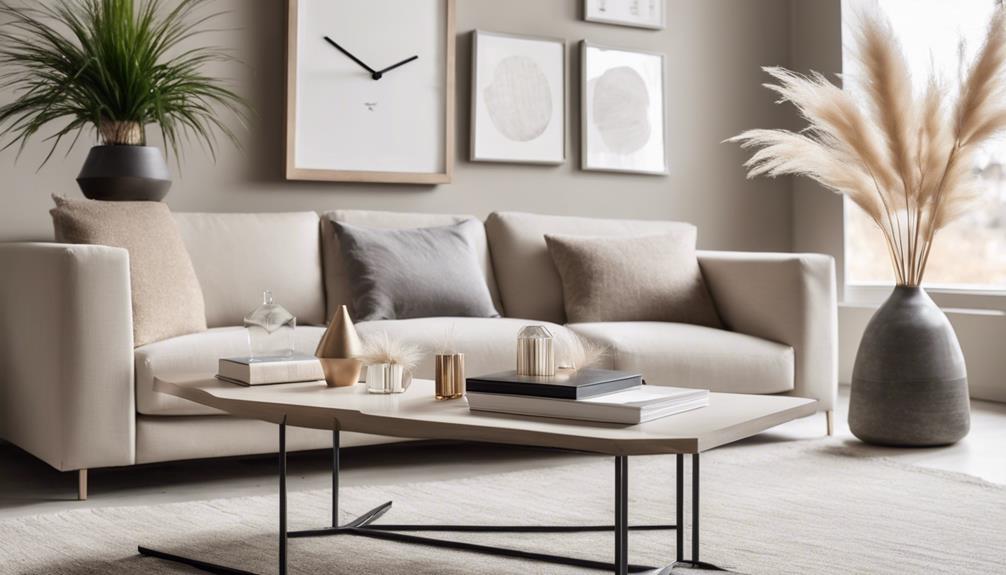
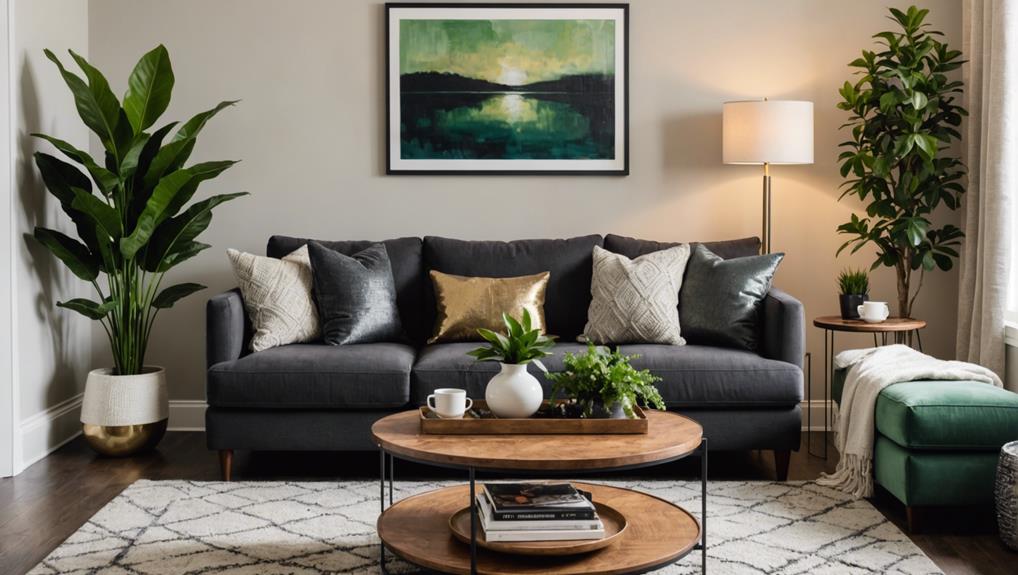
Leave a Reply